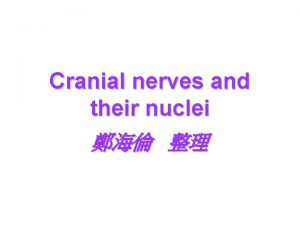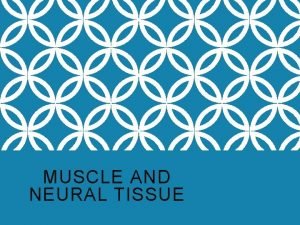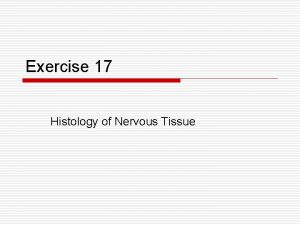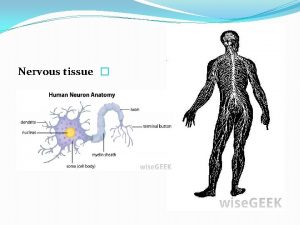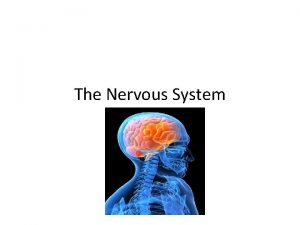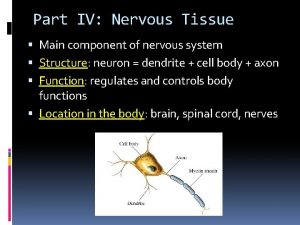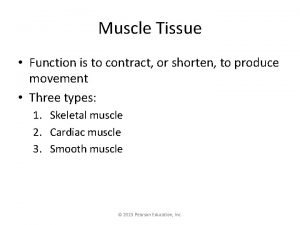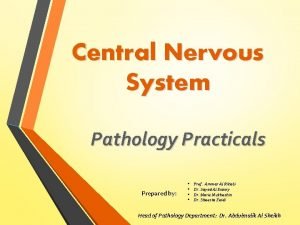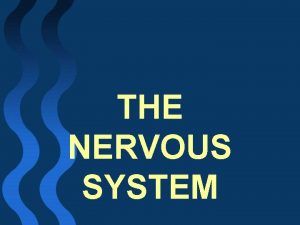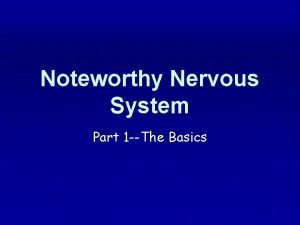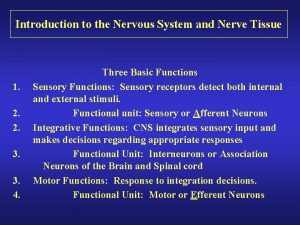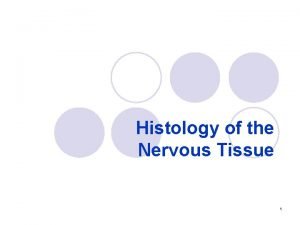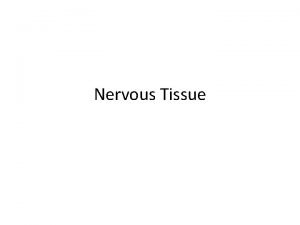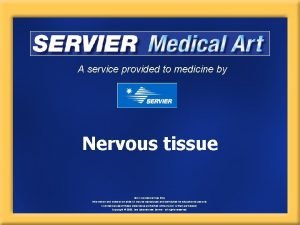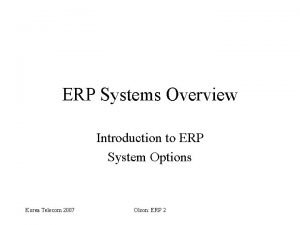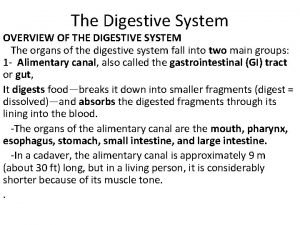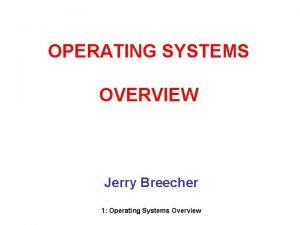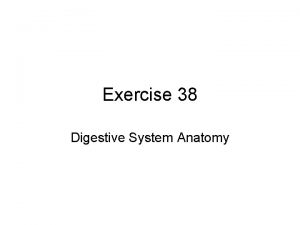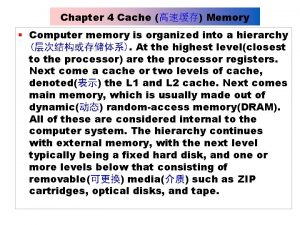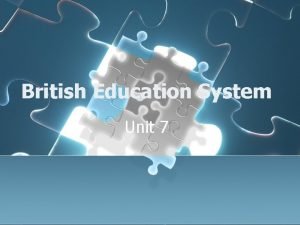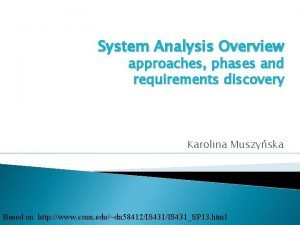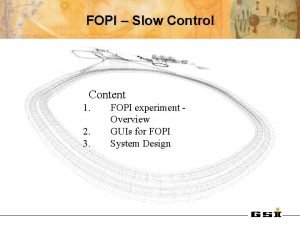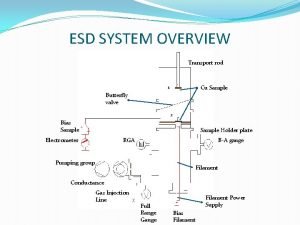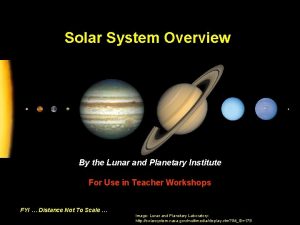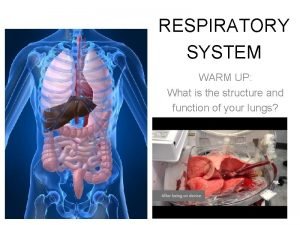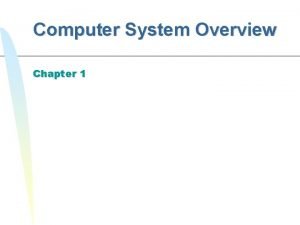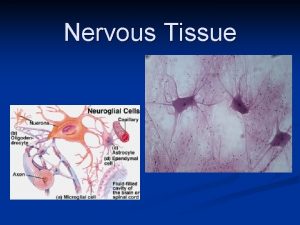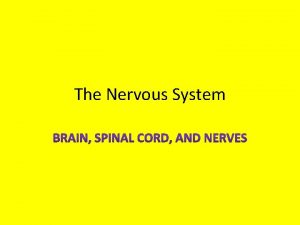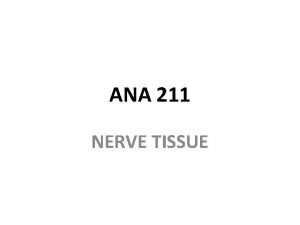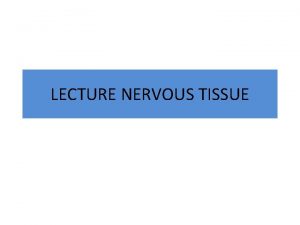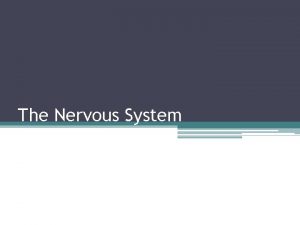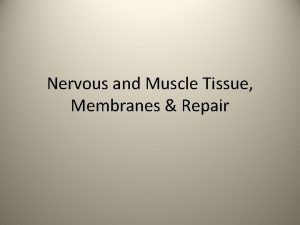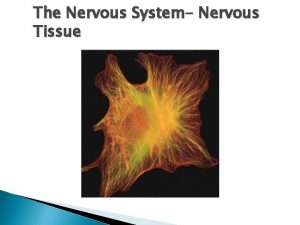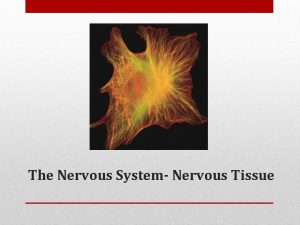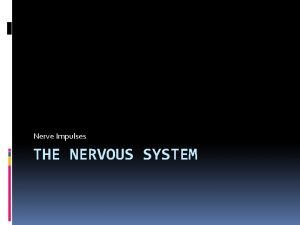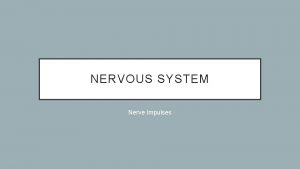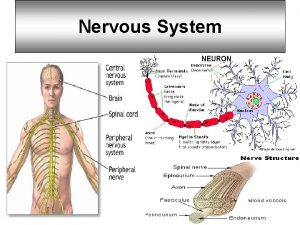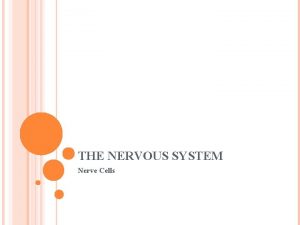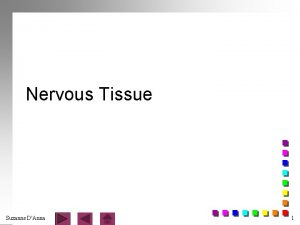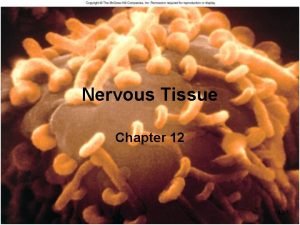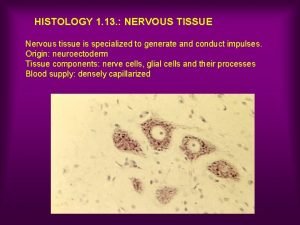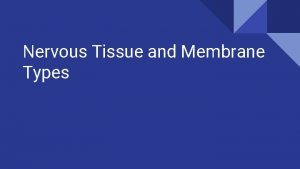Nervous Tissue Overview of the nervous system Nerve


































































- Slides: 66

Nervous Tissue • Overview of the nervous system • Nerve cells (neurons) • Supportive cells (neuroglia) • Electrophysiology of neurons • Synapses • Neural integration 1

Overview of Nervous System • Endocrine and nervous system maintain internal coordination – endocrine = chemical messengers (hormones) delivered to the bloodstream – nervous = three basic steps • sense organs receive information • brain and spinal cord determine responses • brain and spinal cord issue commands to glands and muscles 2

Subdivisions of Nervous System Two major anatomical subdivisions • Central nervous system (CNS) – brain and spinal cord enclosed in bony coverings • Peripheral nervous system (PNS) – nerve = bundle of axons in connective tissue – ganglion = swelling of cell bodies in a nerve 3

Subdivisions of Nervous System 4

Functional Divisions of PNS • Sensory (afferent) divisions (receptors to CNS) – visceral sensory and somatic sensory division • Motor (efferent) division (CNS to effectors) – visceral motor division (ANS) effectors: cardiac, smooth muscle, glands • sympathetic division (action) • parasympathetic division (digestion) – somatic motor division effectors: skeletal muscle 5

Subdivisions of Nervous System 6

Fundamental Types of Neurons • Sensory (afferent) neurons – detect changes in body and external environment – information transmitted into brain or spinal cord • Interneurons (association neurons) – lie between sensory and motor pathways in CNS – 90% of our neurons are interneurons – process, store and retrieve information • Motor (efferent) neuron – send signals out to muscles and gland cells – organs that carry out responses called effectors 7

Fundamental Types of Neurons 8

Properties of Neurons • Excitability (irritability) – ability to respond to changes in the body and external environment called stimuli • Conductivity – produce traveling electrical signals • Secretion – when electrical signal reaches end of nerve fiber, a chemical neurotransmitter is secreted 9

Structure of a Neuron • Cell body = perikaryon = soma – single, central nucleus with large nucleolus – cytoskeleton of microtubules and neurofibrils (bundles of actin filaments) • compartmentalizes RER into Nissl bodies – lipofuscin product of breakdown of worn-out organelles -- more with age • Vast number of short dendrites – for receiving signals • Singe axon (nerve fiber) arising from axon hillock for rapid conduction – axoplasm and axolemma and synaptic vesicles 10

A Representative Neuron 11

Variation in Neural Structure • Multipolar neuron – most common – many dendrites/one axon • Bipolar neuron – one dendrite/one axon – olfactory, retina, ear • Unipolar neuron – sensory from skin and organs to spinal cord • Anaxonic neuron – many dendrites/no axon – help in visual processes 12

Types of Neuroglial Cells 1 • Oligodendrocytes form myelin sheaths in CNS – each wraps around many nerve fibers • Ependymal cells line cavities and produce CSF • Microglia (macrophages) formed from monocytes – in areas of infection, trauma or stroke 13

Types of Neuroglial Cells 2 • Astrocytes – most abundant glial cells - form framework of CNS – contribute to BBB and regulate composition of brain tissue fluid – convert glucose to lactate to feed neurons – secrete nerve growth factor promoting synapse formation – electrical influence on synaptic signaling – sclerosis – damaged neurons replace by hardened mass of astrocytes • Schwann cells myelinate fibers of PNS • Satellite cells with uncertain function 14

Neuroglial Cells of CNS 15

Myelin 1 • Insulating layer around a nerve fiber – oligodendrocytes in CNS and schwann cells in PNS – formed from wrappings of plasma membrane • 20% protein and 80 % lipid (looks white) – all myelination completed by late adolescence • In PNS, hundreds of layers wrap axon – the outermost coil is schwann cell (neurilemma) – covered by basal lamina and endoneurium 16

Myelin 2 • In CNS - no neurilemma or endoneurium • Oligodendrocytes myelinate several fibers – Myelination spirals inward with new layers pushed under the older ones • Gaps between myelin segments = nodes of Ranvier • Initial segment (area before 1 st schwann cell) and axon hillock form trigger zone where signals begin 17

Myelin Sheath • Note: Node of Ranvier between Schwann 18 cells

Myelination in PNS • Myelination begins during fetal development, but proceeds most rapidly in infancy. 19

Unmyelinated Axons of PNS • Schwann cells hold small nerve fibers in grooves on their surface with only one membrane wrapping 20

Myelination in CNS 21

Speed of Nerve Signal • Diameter of fiber and presence of myelin • large fibers have more surface area for signals • Speeds – small, unmyelinated fibers = 0. 5 - 2. 0 m/sec – small, myelinated fibers = 3 - 15. 0 m/sec – large, myelinated fibers = up to 120 m/sec • Functions – slow signals supply the stomach and dilate pupil – fast signals supply skeletal muscles and transport sensory signals for vision and balance 22

Regeneration of Peripheral Nerves • Occurs if soma and neurilemmal tube is intact • Stranded end of axon and myelin sheath degenerate – cell soma swells, ER breaks up and some cells die • Axon stump puts out several sprouts • Regeneration tube guides lucky sprout back to its original destination – schwann cells produce nerve growth factors • Soma returns to its normal appearance 23

Regeneration of Nerve Fiber 24

Electrical Potentials and Currents • Nerve pathway is a series of separate cells • neural communication = mechanisms for producing electrical potentials and currents – electrical potential - different concentrations of charged particles in different parts of the cell – electrical current - flow of charged particles from one point to another within the cell • Living cells are polarized – resting membrane potential is -70 m. V with a negative charge on the inside of membrane 25

Resting Membrane Potential • Unequal electrolytes distribution between ECF/ICF • Diffusion of ions down their concentration gradients • Selective permeability of plasma membrane • Electrical attraction of cations and anions 26

Resting Membrane Potential 2 • Membrane very permeable to K+ – leaks out until electrical gradient created attracts it back in • Cytoplasmic anions can not escape due to size or charge (PO 42 -, SO 42 -, organic acids, proteins) • Membrane much less permeable to Na+ • Na+/K+ pumps out 3 Na+ for every 2 K+ it brings in – works continuously and requires great deal of ATP – necessitates glucose and oxygen be supplied to nerve tissue 27

Ionic Basis of Resting Membrane Potential • Na+ concentrated outside of cell (ECF) • K+ concentrated inside cell (ICF) 28

Local Potentials 1 • Local disturbances in membrane potential – occur when neuron is stimulated by chemicals, light, heat or mechanical disturbance – depolarization decreases potential across cell membrane due to opening of gated Na+ channels • Na+ rushes in down concentration and electrical gradients • Na+ diffuses for short distance inside membrane producing a change in voltage called a local potential 29

Local Potentials 2 • Differences from action potential – are graded (vary in magnitude with stimulus strength) – are decremental (get weaker the farther they spread) – are reversible as K+ diffuses out of cell – can be either excitatory or inhibitory (hyperpolarize) 30

Chemical Excitation 31

Action Potentials • More dramatic change in membrane produced where high density of voltagegated channels occur – trigger zone up to 500 channels/ m 2 (normal is 75) • If threshold potential (-55 m. V) is reached voltage-gated Na+ channels open (Na+ enters causing depolarization) • Past 0 m. V, Na+ channels close = depolarization • Slow K+ gates fully open • K+ exits repolarizing the cell • Negative overshoot produces hyperpolarization – excessive exiting of K+ 32

Action Potentials • Called a spike • Characteristics of AP – follows an all-or-none law • voltage gates either open or don’t – nondecremental (do not get weaker with distance) – irreversible (once started goes to completion and can not be stopped) 33

The Refractory Period • Period of resistance to stimulation • Absolute refractory period – as long as Na+ gates are open – no stimulus will trigger AP • Relative refractory period – as long as K+ gates are open – only especially strong stimulus will trigger new AP • Refractory period is occurring only to a small patch of membrane at one time (quickly recovers) 34

Impulse Conduction in Unmyelinated Fibers • Threshold voltage in trigger zone begins impulse • Nerve signal (impulse) - a chain reaction of sequential opening of voltage-gated Na+ channels down entire length of axon • Nerve signal (nondecremental) travels at 2 m/sec 35

Impulse Conduction - Unmyelinated Fibers 36

Saltatory Conduction - Myelinated Fibers • Voltage-gated channels needed for APs – fewer than 25 per m 2 in myelin-covered regions – up to 12, 000 per m 2 in nodes of Ranvier • Fast Na+ diffusion occurs between nodes 37

Saltatory Conduction • Notice how the action potentials jump from node of Ranvier to node of Ranvier. 38

Synapses between Neurons • First neuron releases neurotransmitter onto second neuron that responds to it – 1 st neuron is presynaptic neuron – 2 nd neuron is postsynaptic neuron • Synapse may be axodendritic, axosomatic or axoaxonic • Number of synapses on postsynaptic cell variable – 8000 on spinal motor neuron – 100, 000 on neuron in cerebellum 39

Synaptic Relationships between Neurons 40

Discovery of Neurotransmitters • Histological observations revealed gap between neurons (synaptic cleft) • Otto Loewi (1873 -1961) demonstrate function of neurotransmitters – flooded exposed hearts of 2 frogs with saline – stimulated vagus nerve --- heart slowed – removed saline from that frog and found it slowed heart of 2 nd frog --- “vagus substance” • later renamed acetylcholine • Electrical synapses do = gap junctions – cardiac and smooth muscle and some neurons 41

Chemical Synapse Structure • Presynaptic neurons have synaptic vesicles with neurotransmitter and postsynaptic have receptors 42

Types of Neurotransmitters • Acetylcholine – • • Amino acid neurotransmitters Monoamines – – – • formed from acetic acid and choline synthesized by replacing –COOH in amino acids with another functional group catecholamines (epi, NE and dopamine) indolamines (serotonin and histamine) Neuropeptides 43

Neuropeptides • Chains of 2 to 40 amino acids • Stored in axon terminal as larger secretory granules (called densecore vesicles) • Act at lower concentrations • Longer lasting effects • Some released from nonneural tissue – gut-brain peptides cause food cravings • Some function as hormones – modify actions of neurotransmitters 44

Synaptic Transmission 3 kinds of synapses with different modes of action • Excitatory cholinergic synapse = ACh • Inhibitory GABA-ergic synapse = GABA • Excitatory adrenergic synapse = NE Synaptic delay (. 5 msec) – time from arrival of nerve signal at synapse to start of AP in postsynaptic cell 45

Excitatory Cholinergic Synapse • Nerve signal opens voltagegated calcium channels in synaptic knob • Triggers release of ACh which crosses synapse • ACh receptors trigger opening of Na+ channels producing local potential (postsynaptic potential) • When reaches -55 m. V, triggers AP in postsynaptic neuron 46

Inhibitory GABA-ergic Synapse • Nerve signal triggers release of GABA ( -aminobutyric acid) which crosses synapse • GABA receptors trigger opening of Clchannels producing hyperpolarization • Postsynaptic neuron now less likely to reach threshold 47

Excitatory Adrenergic Synapse • Neurotransmitter is NE (norepinephrine) • Acts through 2 nd messenger systems (c. AMP) – receptor is an integral membrane protein associated with a G protein, which activates adenylate cyclase, which converts ATP to c. AMP • c. AMP has multiple effects – binds to ion gate inside of membrane (depolarizing) – activates cytoplasmic enzymes – induces genetic transcription and production of new enzymes • Its advantage is enzymatic amplification 48

Excitatory Adrenergic Synapse 49

Cessation and Modification of Signal • Mechanisms to turn off stimulation – diffusion of neurotransmitter away into ECF • astrocytes return it to neurons – synaptic knob reabsorbs amino acids and monoamines by endocytosis – acetylcholinesterase degrades ACh • choline reabsorbed and recycled • Neuromodulators modify transmission – raise or lower number of receptors – alter neurotransmitter release, synthesis or breakdown 50

Neural Integration • More synapses a neuron has the greater its information-processing capability – cells in cerebral cortex with 40, 000 synapses – cerebral cortex estimated to contain 100 trillion synapses • Chemical synapses are decision-making components of the nervous system – ability to process, store and recall information is due to neural integration • Based on types of postsynaptic potentials 51 produced by neurotransmitters

Postsynaptic Potentials- EPSP • Excitatory postsynaptic potentials (EPSP) – a positive voltage change causing postsynaptic cell to be more likely to fire • result from Na+ flowing into the cell – glutamate and aspartate are excitatory neurotransmitters • ACh and norepinephrine may excite or inhibit depending on cell 52

Postsynaptic Potentials- IPSP • Inhibitory postsynaptic potentials (IPSP) – a negative voltage change causing postsynaptic cell to be less likely to fire (hyperpolarize) • result of Cl- flowing into the cell or K+ leaving the cell – glycine and GABA are inhibitory neurotransmitters • ACh and norepinephrine may excite or inhibit depending upon cell 53

Postsynaptic Potentials 54

Summation - Postsynaptic Potentials • Net postsynaptic potentials in trigger zone – firing depends on net input of other cells • typical EPSP voltage = 0. 5 m. V and lasts 20 msec • 30 EPSPs needed to reach threshold – temporal summation • single synapse receives many EPSPs in short time – spatial summation • single synapse receives many EPSPs from many cells 55

Summation of EPSP’s • Does this represent spatial or temporal summation? 56

Presynaptic Inhibition • One presynaptic neuron suppresses another – neuron I releases inhibitory GABA • prevents voltage-gated calcium channels from opening -- it releases less or no neurotransmitter 57

Neural Circuits • Diverging circuit -- one cell synapses on other that each synapse on others • Converging circuit -- input from many fibers on one neuron (respiratory center) • Reverberating circuits – neurons stimulate each other in linear sequence but one cell restimulates the first cell to start the process all over • Parallel after-discharge circuits – input neuron stimulates several pathways which stimulate the output neuron to go on firing for longer time after input has truly stopped 58

Neural Circuits Illustrated 59

Memory and Synaptic Plasticity • Physical basis of memory is a pathway – called a memory trace or engram – new synapses or existing synapses modified to make transmission easier (synaptic plasticity) • Synaptic potentiation – transmission mechanisms correlate with different forms of memory • Immediate, short and long-term memory 60

Immediate Memory • Ability to hold something in your thoughts for just a few seconds – Essential for reading ability • Feel for the flow of events (sense of the present) • Our memory of what just happened “echoes” in our minds for a few seconds – reverberating circuits 61

Short-Term Memory • Lasts from a few seconds to several hours – quickly forgotten if distracted • Search for keys, dial the phone – reverberating circuits • Facilitation causes memory to last longer – tetanic stimulation (rapid, repetitive signals) cause Ca 2+ accumulation and cells more likely to fire • Posttetanic potentiation (to jog a memory) – Ca 2+ level in synaptic knob stays elevated – little stimulation needed to recover memory 62

Long-Term Memory • Types of long-term memory – declarative = retention of facts as text – procedural = retention of motor skills • Physical remodeling of synapses – new branching of axons or dendrites • Molecular changes = long-term – tetanic stimulation causes ionic changes • neuron produces more neurotransmitter receptors • more protein synthesizes for synapse remodeling • releases nitric oxide, then presynaptic neuron 63 releases more neurotransmitter

Alzheimer Disease • 100, 000 deaths/year – 11% of population over 65; 47% by age 85 • Memory loss for recent events, moody, combative, lose ability to talk, walk, and eat • Diagnosis confirmed at autopsy – atrophy of gyri (folds) in cerebral cortex – neurofibrillary tangles and senile plaques • Degeneration of cholinergic neurons and deficiency of ACh and nerve growth factors 64 • Genetic connection confirmed

Alzheimer Disease Effects 65

Parkinson Disease • Progressive loss of motor function beginning in 50’s or 60’s -- no recovery – degeneration of dopamine-releasing neurons • prevents excessive activity in motor centers • involuntary muscle contractions – pill-rolling motion, facial rigidity, slurred speech, – illegible handwriting, slow gait • Treatment = drugs and physical therapy – dopamine precursor crosses brain barrier – MAO inhibitor slows neural degeneration – surgical technique to relieve tremors 66
 Which neuron is rare
Which neuron is rare Nervous
Nervous Processes of nerve cell
Processes of nerve cell Trigeminal nerve which cranial nerve
Trigeminal nerve which cranial nerve Description of nervous tissue
Description of nervous tissue Nervous tissue
Nervous tissue Histology of nervous system ppt
Histology of nervous system ppt Sheep brain labeled
Sheep brain labeled Classify nervous tissue
Classify nervous tissue Nervous tissue in the lungs
Nervous tissue in the lungs Nervous tissue repair
Nervous tissue repair Supporting cells
Supporting cells Alzheimer's disease microscopy
Alzheimer's disease microscopy Nervous tissue
Nervous tissue Nervous tissue
Nervous tissue Nervous tissue
Nervous tissue Nervous tissue
Nervous tissue Nervous tissue diagram
Nervous tissue diagram Nervous tissue definition
Nervous tissue definition Nervous tissue
Nervous tissue Nervous tissue
Nervous tissue Jaringan epitel dapat ditemukan di
Jaringan epitel dapat ditemukan di Nervous system and digestive system
Nervous system and digestive system Endocrine system and nervous system
Endocrine system and nervous system Nervous system vs endocrine system venn diagram
Nervous system vs endocrine system venn diagram Adh function
Adh function Erp system overview
Erp system overview Content management system overview
Content management system overview What is computerized accounting information system
What is computerized accounting information system Overview of the digestive system
Overview of the digestive system Operative indicators in sap ps
Operative indicators in sap ps Operating system overview
Operating system overview Class diagram gym management system
Class diagram gym management system Gastroesophageal histology
Gastroesophageal histology Set associative mapping in cache memory
Set associative mapping in cache memory Computer memory system overview
Computer memory system overview British school system
British school system Chapter 2 an overview of the financial system
Chapter 2 an overview of the financial system British school system overview
British school system overview System design overview
System design overview System design overview
System design overview System overview sample
System overview sample Lpi
Lpi Lung with 3 lobes
Lung with 3 lobes Computer system overview
Computer system overview Hình ảnh bộ gõ cơ thể búng tay
Hình ảnh bộ gõ cơ thể búng tay Lp html
Lp html Bổ thể
Bổ thể Tỉ lệ cơ thể trẻ em
Tỉ lệ cơ thể trẻ em Voi kéo gỗ như thế nào
Voi kéo gỗ như thế nào Tư thế worms-breton
Tư thế worms-breton Bài hát chúa yêu trần thế alleluia
Bài hát chúa yêu trần thế alleluia Các môn thể thao bắt đầu bằng tiếng chạy
Các môn thể thao bắt đầu bằng tiếng chạy Thế nào là hệ số cao nhất
Thế nào là hệ số cao nhất Các châu lục và đại dương trên thế giới
Các châu lục và đại dương trên thế giới Cong thức tính động năng
Cong thức tính động năng Trời xanh đây là của chúng ta thể thơ
Trời xanh đây là của chúng ta thể thơ Mật thư anh em như thể tay chân
Mật thư anh em như thể tay chân Làm thế nào để 102-1=99
Làm thế nào để 102-1=99 độ dài liên kết
độ dài liên kết Các châu lục và đại dương trên thế giới
Các châu lục và đại dương trên thế giới Thơ thất ngôn tứ tuyệt đường luật
Thơ thất ngôn tứ tuyệt đường luật Quá trình desamine hóa có thể tạo ra
Quá trình desamine hóa có thể tạo ra Một số thể thơ truyền thống
Một số thể thơ truyền thống Cái miệng nó xinh thế chỉ nói điều hay thôi
Cái miệng nó xinh thế chỉ nói điều hay thôi Vẽ hình chiếu vuông góc của vật thể sau
Vẽ hình chiếu vuông góc của vật thể sau Biện pháp chống mỏi cơ
Biện pháp chống mỏi cơ



